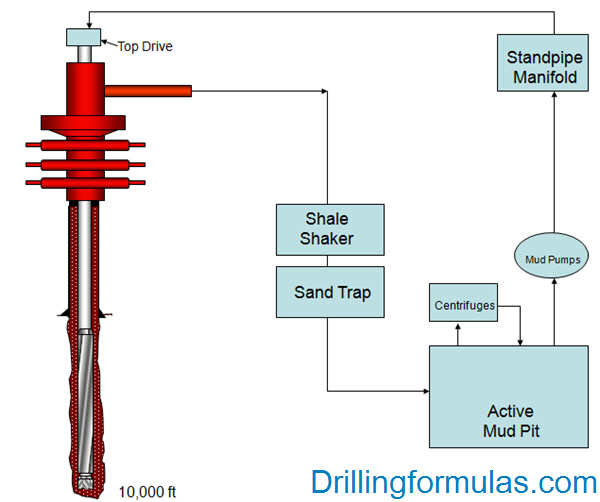
Lag time is traveling time interval required for pumping cuttings from each particular depth to surface. It can be expressed in terms of time (minutes) and pump strokes.

The lag time always changes when a well becomes deeper and/or pumping speed change. Two factors, affecting lag time calculation, are annulus volume of drilling fluid in and drilling mud flow rate.
With certain annular volume, the lag time, normally expressed in minutes, can be determined by dividing the annular volume (bbls) by the flow rate (bbl/min).
If there are changes in mud flow rate, the lag time figure will be changed as well. In order compensate for any changes, the lag time is transformed into pump strokes too; therefore, a change in speed of pump will not affect the lag time.
How to Calculate Theoretical Lag Time
There are 3 steps to do in order to calculate lag time as listed below;
1. Calculate pump output
2. Calculate annular volume at certain depth of hole
3. Calculate the theoretical lag time
Oilfield Unit
Example – Determine lag time from bottom to surface with the following information;
Bit depth = 9500’ MD
Pump rate = 300 GPM
Annular volume at 9500’ MD = 250 bbl
Triplex pump output = 0.102 bbl/stroke
Solution;
Pump rate = 300 GPM ÷ 42 = 7.14 bbl / minute
Lag time in minutes = 250 bbl ÷ 7.14 bbl / minute = 35 minutes
Lag time in strokes = 250 bbl ÷ 0.102 bbl/stroke = 2451 strokes
Metric Unit
Bit depth = 3,300 m
Pump rate = 1,200 liter/min
Annular volume at 3,300 m = 40 m3
Triplex pump output = 0.01622 m3/stroke
Solution;
Lag time in minutes = 40 m3 ÷ (1,200 ÷ 1,000 m3/ min) = 33.3 minutes
Lag time in strokes = 40 m3 ÷ 0.01622 m3/stroke = 2466 strokes
Download Lag Time Calculation Spreadsheet

Ref books:
Lapeyrouse, N.J., 2002. Formulas and calculations for drilling, production and workover, Boston: Gulf Professional publishing.
Bourgoyne, A.J.T., Chenevert , M.E. & Millheim, K.K., 1986. SPE Textbook Series, Volume 2: Applied Drilling Engineering, Society of Petroleum Engineers.
Mitchell, R.F., Miska, S. & Aadny, B.S., 2011. Fundamentals of drilling engineering, Richardson, TX: Society of Petroleum Engineers.













